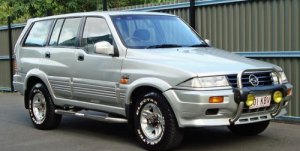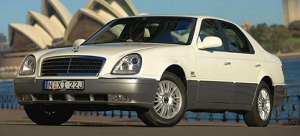
| - |
2020: 107,416 units
2019: 135,235 units
2018: 143,309 units
2017: 143,685 units
2016: 155,844 units
2015: 144,764 units
2014: 141,047 units
2013: 145,649 units
2012: 120,717 units
2011: 113,000 units
2008: 92,665 units
2007: 136,000 units
2006: 121,196 units
2005: 141,306 units
2004: 135,600 units
Reference:
http://www.smotor.com/en/ir/fin_info/summary/index.html
Previously owned by Daewoo from 1998 and then SAIC of China from 2004, Ssangyong went into receivership again in early 2009.
In the early '80s, Dong-A acquired SUV maker Keowha, which made 4WD offroaders licensed from Jeep. The merged company was renamed to Ssangyong in 1986, since then it concentrated on SUVs.
 1993 Musso
1993 MussoThe turning point was in 1991, when it signed a technical cooperation agreement with Mercedes-Benz for transferring its engine technology and helped it to develop light commercial vehicles. This resulted in many Ssangyong cars and SUVs powered by Mercedes straight-six. The Musso of 1993 and Korando of 1996 successfully opened the gate of export. Later, Mercedes even helped Ssangyong to develop its first passenger car - the Chairman luxurious limousine - based on its E-class.
To produce the Mercedes engines, Ssangyong built its second plant in Changwon. Aggressive expansion led to substantial debt and its eventual bankruptcy during the 1998 Asian financial crisis. Then it was received by Daewoo. However, in 2000 Daewoo itself also went into receivership. Ssangyong, benefited by its strong basis in SUV business and the better prospect of global SUV market, received support from its creditors and spun off from Daewoo.
 1997 Chairman
1997 ChairmanIn 2004, Chinese car maker SAIC acquired controlling stakes in Ssangyong and became its new owner. Nevertheless, its financial condition did not improve. Having lost US$500 million in 2008, SAIC called for surrender and sent its cash-strapped Korean subsidiary to bankruptcy protection. In 2010, it was acquired by Indian truck maker Mahindra, but that relationship ended 10 years later, as Mahindra failed to turn around it. Ssangyong went into receivership. In 2022 it was sold to Korean firm KG and rebranded to KG Mobility the next year.